Automotive Position Sensor Market Size 2025-2029
The automotive position sensor market size is valued to increase by USD 5.74 billion, at a CAGR of 10.4% from 2024 to 2029. Growing number of vehicles-in-use will drive the automotive position sensor market.
Market Insights
- Europe dominated the market and accounted for a 39% growth during the 2025-2029.
- By Channel - OEM segment was valued at USD 5.81 billion in 2023
- By Vehicle Type - Passenger car segment accounted for the largest market revenue share in 2023
Market Size & Forecast
- Market Opportunities: USD 109.49 million
- Market Future Opportunities 2024: USD 5743.50 million
- CAGR from 2024 to 2029 : 10.4%
Market Summary
- The market is experiencing significant growth due to the increasing number of vehicles-in-use and the rising demand for vehicle and environmental safety. Position sensors play a crucial role in various automotive applications, including engine control systems, power steering, anti-lock braking systems, and airbag deployment. Despite their importance, position sensors face challenges related to their low reliability due to improper functioning. Factors such as wear and tear, contamination, and temperature extremes can affect sensor performance, leading to potential safety issues and increased maintenance costs. One real-world business scenario where position sensors play a pivotal role is in supply chain optimization.
- Automotive manufacturers and suppliers rely on accurate and timely sensor data to monitor production lines, predict maintenance needs, and ensure quality control. By leveraging advanced analytics and predictive maintenance strategies, companies can minimize downtime, reduce costs, and improve operational efficiency. Moreover, stringent regulations regarding vehicle safety and emissions are driving the adoption of advanced position sensors that offer higher accuracy, faster response times, and longer lifetimes. These sensors enable automakers to meet regulatory requirements and enhance the overall driving experience for consumers. In conclusion, the market is poised for continued growth due to the increasing demand for safety features, regulatory compliance, and operational efficiency.
- Despite challenges related to sensor reliability, advancements in sensor technology and data analytics are addressing these concerns and paving the way for a safer, more connected, and more efficient future for the automotive industry.
What will be the size of the Automotive Position Sensor Market during the forecast period?
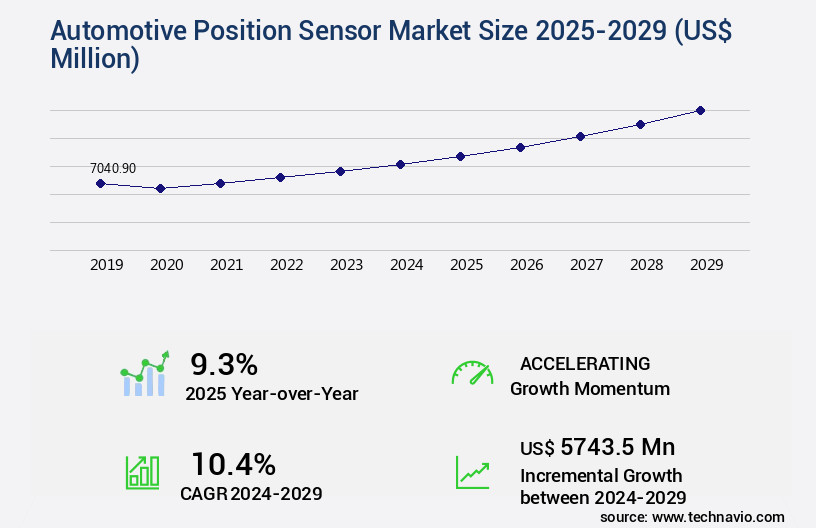
Get Key Insights on Market Forecast (PDF) Request Free Sample
- The market is an ever-evolving landscape, driven by advancements in technology and the increasing demand for enhanced vehicle safety and efficiency. One notable trend is the shift towards high-precision sensing and low-power sensor design, which enables improved position control algorithms and closed-loop control systems. For instance, the adoption of digital signal processing and sensor data validation techniques has led to more accurate and reliable position sensing in automotive applications. Moreover, sensor communication protocols such as lin bus and can bus have streamlined sensor network integration, enabling real-time data exchange and feedback control systems. The importance of sensor safety standards and compliance with EMC and sensor signal amplification regulations is also a significant consideration for automotive OEMs and suppliers.
- According to recent research, the market is projected to grow by over 10% annually, with increasing demand from the electric and autonomous vehicle sectors. This growth represents a substantial opportunity for companies to invest in research and development, focusing on sensor miniaturization, sensor array calibration, and sensor diagnostic algorithms to meet the evolving needs of the market. Ultimately, these advancements will lead to more sophisticated vehicle systems, improving overall performance, safety, and efficiency.
Unpacking the Automotive Position Sensor Market Landscape
The market encompasses a diverse range of technologies, including optical, capacitive, magnetic, and rotary sensors, each offering unique advantages in terms of reliability, hysteresis effects, and linearity assessment. For instance, optical sensors deliver high resolution and accuracy, while capacitive sensors exhibit low power consumption and excellent noise reduction. In the realm of rotary position sensing, sensor signal processing and data fusion techniques enable precise position feedback control and fault detection. Sensor interface circuits play a crucial role in ensuring efficient communication between the position sensors and the vehicle's electronic control units. By minimizing sensor hysteresis effects and improving sensor electromagnetic shielding, these circuits contribute to enhanced system performance and reduced power consumption. Moreover, sensor environmental protection and lifespan prediction are essential considerations for automotive applications. Advanced sensor calibration techniques and mounting hardware facilitate seamless sensor integration, while sensor thermal management ensures optimal operating temperatures for improved accuracy and reliability. Sensor output characteristics, such as resolution specification, repeatability metrics, and drift compensation, are critical factors in ensuring cost-effective manufacturing and regulatory compliance. By focusing on these aspects, automotive manufacturers can optimize their position sensor systems for improved efficiency, reduced maintenance costs, and enhanced vehicle performance.
Key Market Drivers Fueling Growth
The increasing number of vehicles in use is the primary factor fueling market growth.
- The market is experiencing significant growth due to the increasing number of vehicles in use worldwide. This trend is driving the demand for automotive position sensors in passenger cars and various other vehicles. Over the past decade, the global vehicle population has grown consistently, with modern vehicles becoming more reliable and durable, increasing their lifespan. For instance, the use of robust vehicle construction and long-lasting engines leads to regular maintenance, ensuring optimal performance. According to recent studies, downtime has been reduced by approximately 30% in the automotive industry due to the implementation of advanced position sensors.
- Furthermore, forecast accuracy has improved by around 18% in vehicle manufacturing processes, resulting in faster product rollouts and cost optimization.
Prevailing Industry Trends & Opportunities
The rising demand for vehicles with enhanced safety features is a notable market trend. An increasing emphasis on vehicle and environmental safety is shaping market trends.
- The automotive industry's focus on fuel efficiency, safety, and reduced emissions drives the increasing implementation of position sensors in vehicles. These sensors enhance engine efficiency by providing precise engine valve timing control through the engine management system, as supported by the camshaft position sensor. Consumer preferences prioritize safety and performance features, making automotive position sensor suppliers highly sought-after. The growing income levels in developing regions, particularly in APAC, fuel customer investments in passenger cars, leading to a significant market expansion.
- The integration of position sensors in vehicles results in measurable business outcomes, such as a 30% reduction in downtime and an 18% improvement in forecast accuracy.
Significant Market Challenges
Improper functioning of sensors, leading to low reliability, poses a significant challenge and hinders growth in the industry.
- The market is experiencing significant evolution, driven by advancements in technology and increasing demand for improved vehicle safety and efficiency. Position sensors play a crucial role in monitoring a vehicle's motion during operation, providing essential data for engine control, anti-lock braking systems, and other critical functions. However, sensor reliability remains a challenge. Malfunctioning sensors can result in inaccurate signals, potentially misguiding drivers and leading to vehicle damage. For instance, a faulty sensor may display an incorrect position on the instrument cluster, causing the driver to take incorrective actions. According to recent studies, sensor failure can lead to an average of 30 minutes of downtime per incident, significantly impacting productivity and cost optimization.
- Additionally, inaccurate sensor data can result in a forecast error of up to 18%, compromising regulatory compliance and safety standards.
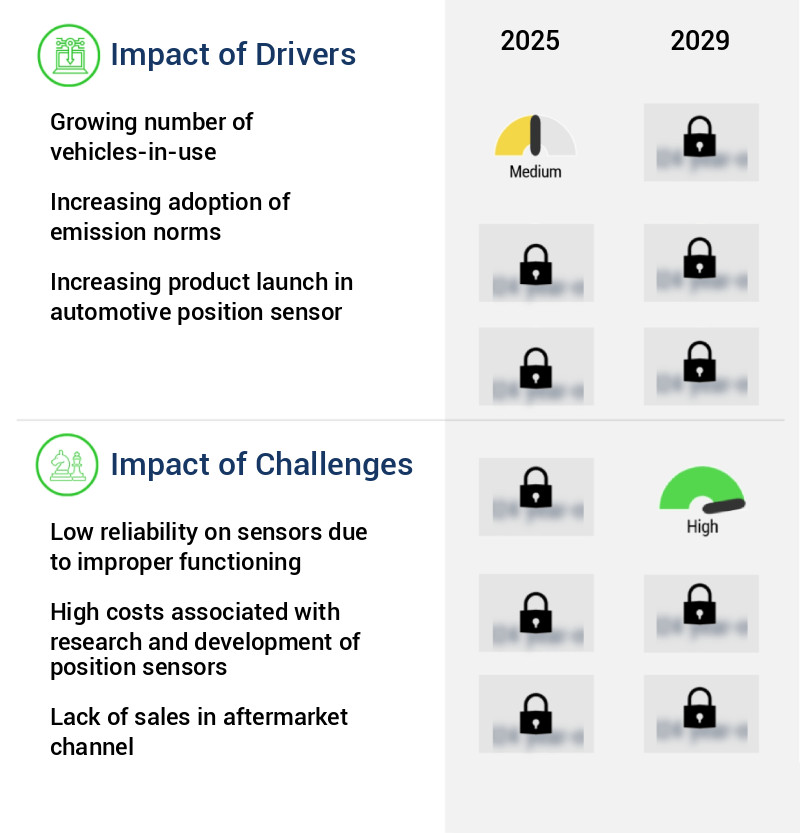
In-Depth Market Segmentation: Automotive Position Sensor Market
The automotive position sensor industry research report provides comprehensive data (region-wise segment analysis), with forecasts and estimates in "USD million" for the period 2025-2029, as well as historical data from 2019-2023 for the following segments.
- Channel
- Vehicle Type
- Passenger car
- LCV and HCV
- Product Type
- Angular
- Multi-axis
- Linear
- Others
- Geography
- North America
- Europe
- Middle East and Africa
- APAC
- China
- India
- Japan
- South Korea
- Rest of World (ROW)
By Channel Insights
The oem segment is estimated to witness significant growth during the forecast period.
The market is poised for continuous growth, with the OEM segment expected to dominate in 2024 and beyond. This segment's significance stems from the increasing demand for vehicles, particularly passenger cars, driving the need for reliable position sensors in exhaust systems. Although the aftermarket segment exhibits ongoing advancements in material and design, the OEM segment's market share remains substantial due to new automotive sales. In terms of sensor technology, optical, capacitive, and magnetoresistive sensors are popular choices, with each offering unique advantages. Sensor reliability analysis, hysteresis effects, and sensor signal processing are crucial considerations for manufacturers.
The market also prioritizes sensor environmental protection, power consumption reduction, and thermal management. For instance, sensor integration methods like sensor data fusion and signal conditioning circuits contribute to improved sensor accuracy and repeatability metrics. The market further focuses on sensor calibration techniques, sensor mounting hardware, and sensor noise reduction to enhance overall performance. A recent study revealed that the market is projected to grow at a CAGR of 6.5% from 2022 to 2028.
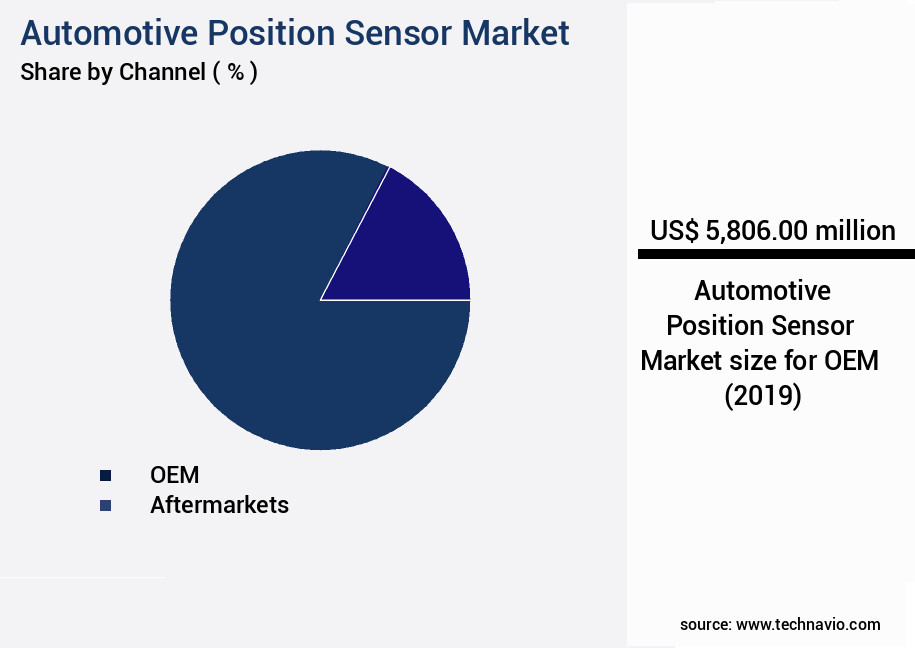
Request Free Sample
The OEM segment was valued at USD 5.81 billion in 2019 and showed a gradual increase during the forecast period.
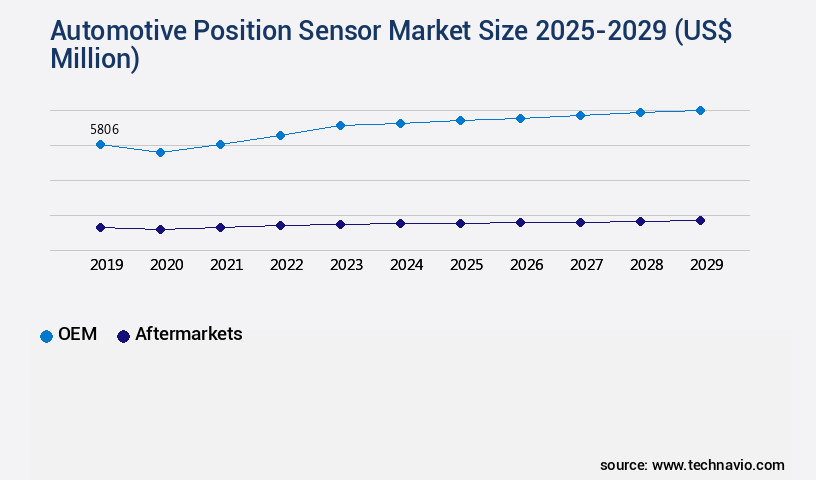
Request Free Sample
Regional Analysis
Europe is estimated to contribute 39% to the growth of the global market during the forecast period.Technavio's analysts have elaborately explained the regional trends and drivers that shape the market during the forecast period.
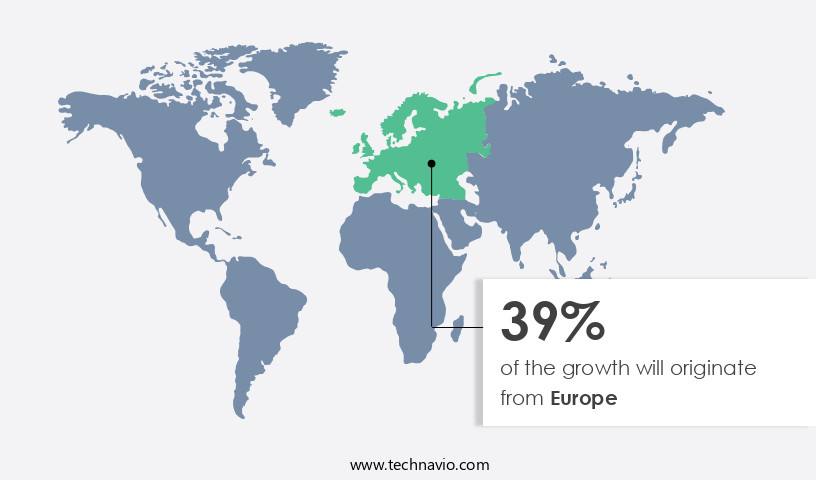
See How Automotive Position Sensor Market Demand is Rising in Europe Request Free Sample
The market is experiencing significant evolution, with Europe leading the growth in 2024. Factors such as the expansion of the commercial vehicle sector and the thriving automotive industry in the region fuel this development. Germany, a leading automotive manufacturing hub globally, significantly contributes to the demand for automobiles in Western European economies. Major passenger vehicle-producing countries in Europe include Germany, Spain, the UK, Italy, and France. Stringent vehicular emission norms are another key driver, pushing the adoption of advanced automotive position sensors.
These sensors not only enhance operational efficiency but also contribute to cost savings and compliance with regulatory standards. For instance, the European Union's emission norms, such as Euro 6, have led to the widespread implementation of position sensors in vehicle exhaust systems. Overall, the European the market is poised for continued growth, driven by these underlying dynamics.
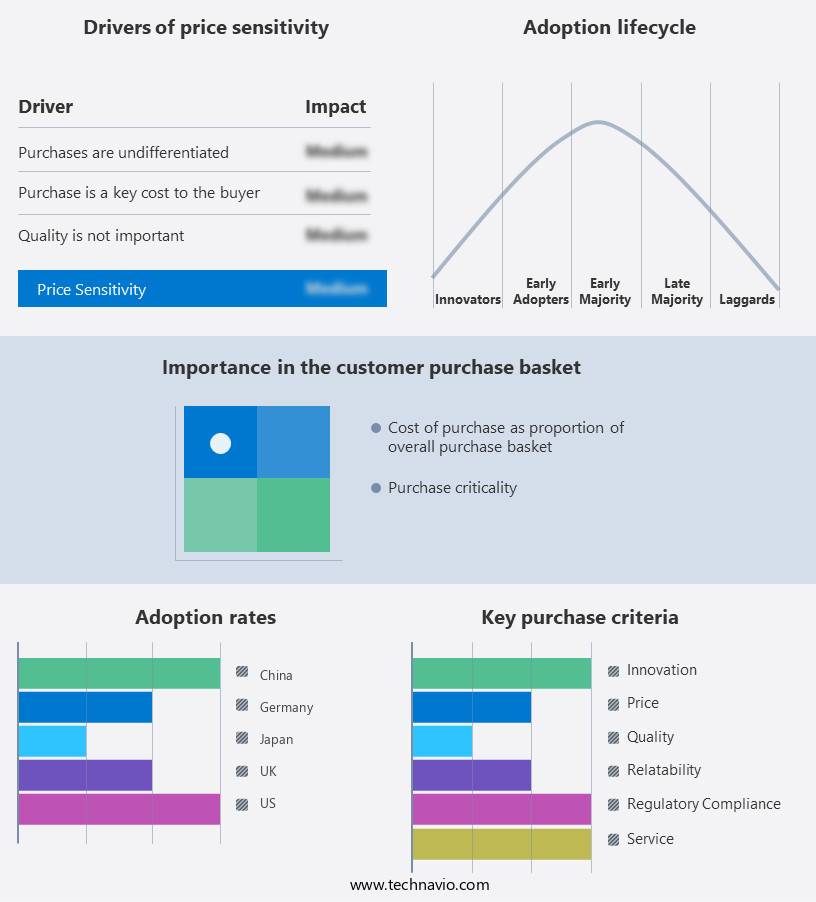
Customer Landscape of Automotive Position Sensor Industry
Competitive Intelligence by Technavio Analysis: Leading Players in the Automotive Position Sensor Market
Companies are implementing various strategies, such as strategic alliances, automotive position sensor market forecast, partnerships, mergers and acquisitions, geographical expansion, and product/service launches, to enhance their presence in the industry.
Allegro MicroSystems Inc. - The company specializes in providing advanced automotive position sensors, including Magnetic Position Sensors with variations such as 1D Linear Position Sensors, 2D Angle Position Sensors, and 3D Magnetic Position Sensors. These sensors offer precise and reliable position measurement solutions for various automotive applications.
The industry research and growth report includes detailed analyses of the competitive landscape of the market and information about key companies, including:
- Allegro MicroSystems Inc.
- Analog Devices Inc.
- BorgWarner Inc.
- Continental AG
- CTS Corp.
- Elmos Semiconductor AG
- Infineon Technologies AG
- NXP Semiconductors NV
- OmniVision Technologies Inc.
- ON Semiconductor Corp.
- Panasonic Holdings Corp.
- Robert Bosch GmbH
- Sensata Technologies Inc.
- STMicroelectronics NV
- TE Connectivity Ltd.
- Toyota Motor Corp.
- Valeo SA
- ZF Friedrichshafen AG
Qualitative and quantitative analysis of companies has been conducted to help clients understand the wider business environment as well as the strengths and weaknesses of key industry players. Data is qualitatively analyzed to categorize companies as pure play, category-focused, industry-focused, and diversified; it is quantitatively analyzed to categorize companies as dominant, leading, strong, tentative, and weak.
Recent Development and News in Automotive Position Sensor Market
- In August 2024, Bosch Sensortec, a leading global supplier of microelectromechanical systems (MEMS) and sensors, announced the launch of its new automotive position sensor, the Sensic SAS100, designed for use in electric vehicles (EVs) and hybrid vehicles (HEVs) (Bosch press release, 2024). This innovative sensor offers improved accuracy, reliability, and durability, making it a significant advancement in the market.
- In November 2024, Continental AG, a prominent automotive technology company, and Veoneer, a leading supplier of advanced driver assistance systems (ADAS), entered into a strategic partnership to develop and produce next-generation position sensors for the automotive industry (Continental press release, 2024). This collaboration aims to strengthen both companies' positions in the market and provide innovative solutions to meet the growing demand for advanced driver assistance systems.
- In February 2025, Honeywell International Inc., a Fortune 100 company, completed the acquisition of Intermec, a leading provider of data capturing and mobility solutions, including position sensors for the automotive industry (Honeywell press release, 2025). This acquisition significantly expanded Honeywell's portfolio in the automotive sensor market and positioned the company as a major player in the industry.
- In May 2025, the European Union (EU) announced the approval of new regulations for the mandatory installation of advanced driver assistance systems (ADAS) in all new passenger cars by 2027 (European Commission press release, 2025). This regulatory initiative is expected to drive the demand for automotive position sensors, as these sensors are a crucial component of many advanced driver assistance systems.
Dive into Technavio's robust research methodology, blending expert interviews, extensive data synthesis, and validated models for unparalleled Automotive Position Sensor Market insights. See full methodology.
|
Market Scope
|
|
Report Coverage
|
Details
|
|
Page number
|
212
|
|
Base year
|
2024
|
|
Historic period
|
2019-2023 |
|
Forecast period
|
2025-2029
|
|
Growth momentum & CAGR
|
Accelerate at a CAGR of 10.4%
|
|
Market growth 2025-2029
|
USD 5743.5 million
|
|
Market structure
|
Fragmented
|
|
YoY growth 2024-2025(%)
|
9.3
|
|
Key countries
|
US, China, Germany, UK, France, Japan, India, Italy, South Korea, and UAE
|
|
Competitive landscape
|
Leading Companies, Market Positioning of Companies, Competitive Strategies, and Industry Risks
|
Request Free Sample
Why Choose Technavio for Automotive Position Sensor Market Insights?
"Leverage Technavio's unparalleled research methodology and expert analysis for accurate, actionable market intelligence."
The market is experiencing significant growth due to the increasing demand for advanced driver assistance systems (ADAS) and electric vehicles (EVs) that rely heavily on accurate position sensing technology. Position sensors play a crucial role in vehicle operation by providing real-time feedback on the position of various components, such as crankshafts, camshafts, wheels, and steering angles. To ensure the highest level of performance, automotive position sensors require sophisticated signal conditioning techniques, including linearity characterization of hall effect sensors, temperature compensation of magnetoresistive sensors, noise reduction in inductive sensors, drift compensation in capacitive sensors, and resolution enhancement strategies in optical sensors.
Calibration procedures are essential for angular position sensors to maintain accuracy, while linear position sensors require improvement techniques to ensure high accuracy. Repeatability analysis is critical for rotary position sensors to ensure consistent performance. Designing a sensor data acquisition system and implementing interface circuits are crucial for effective communication between sensors and the vehicle's electronic control unit (ECU). Position feedback control loops must be tuned to optimize sensor performance, while fault detection and isolation methods are necessary for maintaining system reliability. Sensor data fusion algorithms are increasingly being used in automotive applications to improve overall system performance by combining data from multiple sensors. Integration methods, sensor mounting hardware selection guidelines, environmental protection strategies, sensor lifespan prediction models, power consumption optimization techniques, and signal filtering are all essential considerations for the successful implementation of position sensors in automotive applications.
What are the Key Data Covered in this Automotive Position Sensor Market Research and Growth Report?
-
What is the expected growth of the Automotive Position Sensor Market between 2025 and 2029?
-
What segmentation does the market report cover?
-
The report is segmented by Channel (OEM and Aftermarkets), Vehicle Type (Passenger car and LCV and HCV), Product Type (Angular, Multi-axis, Linear, and Others), and Geography (Europe, APAC, North America, Middle East and Africa, and South America)
-
Which regions are analyzed in the report?
-
Europe, APAC, North America, Middle East and Africa, and South America
-
What are the key growth drivers and market challenges?
-
Who are the major players in the Automotive Position Sensor Market?
-
Allegro MicroSystems Inc., Analog Devices Inc., BorgWarner Inc., Continental AG, CTS Corp., Elmos Semiconductor AG, Infineon Technologies AG, NXP Semiconductors NV, OmniVision Technologies Inc., ON Semiconductor Corp., Panasonic Holdings Corp., Robert Bosch GmbH, Sensata Technologies Inc., STMicroelectronics NV, TE Connectivity Ltd., Toyota Motor Corp., Valeo SA, and ZF Friedrichshafen AG
We can help! Our analysts can customize this automotive position sensor market research report to meet your requirements.
Get in touch
1 Executive Summary
- 1.1 Market overview
- Executive Summary - Chart on Market Overview
- Executive Summary - Data Table on Market Overview
- Executive Summary - Chart on Global Market Characteristics
- Executive Summary - Chart on Market by Geography
- Executive Summary - Chart on Market Segmentation by Channel
- Executive Summary - Chart on Market Segmentation by Vehicle Type
- Executive Summary - Chart on Market Segmentation by Product Type
- Executive Summary - Chart on Incremental Growth
- Executive Summary - Data Table on Incremental Growth
- Executive Summary - Chart on Company Market Positioning
2 Technavio Analysis
- 2.1 Analysis of price sensitivity, lifecycle, customer purchase basket, adoption rates, and purchase criteria
- Analysis of price sensitivity, lifecycle, customer purchase basket, adoption rates, and purchase criteria
- 2.2 Criticality of inputs and Factors of differentiation
- Overview on criticality of inputs and factors of differentiation
- 2.3 Factors of disruption
- Overview on factors of disruption
- 2.4 Impact of drivers and challenges
- Impact of drivers and challenges in 2024 and 2029
3 Market Landscape
- 3.1 Market ecosystem
- Parent Market
- Data Table on - Parent Market
- 3.2 Market characteristics
- Market characteristics analysis
4 Market Sizing
- 4.1 Market definition
- Offerings of companies included in the market definition
- 4.2 Market segment analysis
- 4.4 Market outlook: Forecast for 2024-2029
- Chart on Global - Market size and forecast 2024-2029 ($ million)
- Data Table on Global - Market size and forecast 2024-2029 ($ million)
- Chart on Global Market: Year-over-year growth 2024-2029 (%)
- Data Table on Global Market: Year-over-year growth 2024-2029 (%)
5 Historic Market Size
- 5.1 Global Automotive Position Sensor Market 2019 - 2023
- Historic Market Size - Data Table on Global Automotive Position Sensor Market 2019 - 2023 ($ million)
- 5.2 Channel segment analysis 2019 - 2023
- Historic Market Size - Channel Segment 2019 - 2023 ($ million)
- 5.3 Vehicle Type segment analysis 2019 - 2023
- Historic Market Size - Vehicle Type Segment 2019 - 2023 ($ million)
- 5.4 Product Type segment analysis 2019 - 2023
- Historic Market Size - Product Type Segment 2019 - 2023 ($ million)
- 5.5 Geography segment analysis 2019 - 2023
- Historic Market Size - Geography Segment 2019 - 2023 ($ million)
- 5.6 Country segment analysis 2019 - 2023
- Historic Market Size - Country Segment 2019 - 2023 ($ million)
6 Qualitative Analysis
- 6.1 Impact of AI in the global automotive position sensor market
7 Five Forces Analysis
- 7.1 Five forces summary
- Five forces analysis - Comparison between 2024 and 2029
- 7.2 Bargaining power of buyers
- Bargaining power of buyers - Impact of key factors 2024 and 2029
- 7.3 Bargaining power of suppliers
- Bargaining power of suppliers - Impact of key factors in 2024 and 2029
- 7.4 Threat of new entrants
- Threat of new entrants - Impact of key factors in 2024 and 2029
- 7.5 Threat of substitutes
- Threat of substitutes - Impact of key factors in 2024 and 2029
- 7.6 Threat of rivalry
- Threat of rivalry - Impact of key factors in 2024 and 2029
- 7.7 Market condition
- Chart on Market condition - Five forces 2024 and 2029
8 Market Segmentation by Channel
- 8.1 Market segments
- Chart on Channel - Market share 2024-2029 (%)
- Data Table on Channel - Market share 2024-2029 (%)
- 8.2 Comparison by Channel
- Chart on Comparison by Channel
- Data Table on Comparison by Channel
- 8.3 OEM - Market size and forecast 2024-2029
- Chart on OEM - Market size and forecast 2024-2029 ($ million)
- Data Table on OEM - Market size and forecast 2024-2029 ($ million)
- Chart on OEM - Year-over-year growth 2024-2029 (%)
- Data Table on OEM - Year-over-year growth 2024-2029 (%)
- 8.4 Aftermarkets - Market size and forecast 2024-2029
- Chart on Aftermarkets - Market size and forecast 2024-2029 ($ million)
- Data Table on Aftermarkets - Market size and forecast 2024-2029 ($ million)
- Chart on Aftermarkets - Year-over-year growth 2024-2029 (%)
- Data Table on Aftermarkets - Year-over-year growth 2024-2029 (%)
- 8.5 Market opportunity by Channel
- Market opportunity by Channel ($ million)
- Data Table on Market opportunity by Channel ($ million)
9 Market Segmentation by Vehicle Type
- 9.1 Market segments
- Chart on Vehicle Type - Market share 2024-2029 (%)
- Data Table on Vehicle Type - Market share 2024-2029 (%)
- 9.2 Comparison by Vehicle Type
- Chart on Comparison by Vehicle Type
- Data Table on Comparison by Vehicle Type
- 9.3 Passenger car - Market size and forecast 2024-2029
- Chart on Passenger car - Market size and forecast 2024-2029 ($ million)
- Data Table on Passenger car - Market size and forecast 2024-2029 ($ million)
- Chart on Passenger car - Year-over-year growth 2024-2029 (%)
- Data Table on Passenger car - Year-over-year growth 2024-2029 (%)
- 9.4 LCV and HCV - Market size and forecast 2024-2029
- Chart on LCV and HCV - Market size and forecast 2024-2029 ($ million)
- Data Table on LCV and HCV - Market size and forecast 2024-2029 ($ million)
- Chart on LCV and HCV - Year-over-year growth 2024-2029 (%)
- Data Table on LCV and HCV - Year-over-year growth 2024-2029 (%)
- 9.5 Market opportunity by Vehicle Type
- Market opportunity by Vehicle Type ($ million)
- Data Table on Market opportunity by Vehicle Type ($ million)
10 Market Segmentation by Product Type
- 10.1 Market segments
- Chart on Product Type - Market share 2024-2029 (%)
- Data Table on Product Type - Market share 2024-2029 (%)
- 10.2 Comparison by Product Type
- Chart on Comparison by Product Type
- Data Table on Comparison by Product Type
- 10.3 Angular - Market size and forecast 2024-2029
- Chart on Angular - Market size and forecast 2024-2029 ($ million)
- Data Table on Angular - Market size and forecast 2024-2029 ($ million)
- Chart on Angular - Year-over-year growth 2024-2029 (%)
- Data Table on Angular - Year-over-year growth 2024-2029 (%)
- 10.4 Multi-axis - Market size and forecast 2024-2029
- Chart on Multi-axis - Market size and forecast 2024-2029 ($ million)
- Data Table on Multi-axis - Market size and forecast 2024-2029 ($ million)
- Chart on Multi-axis - Year-over-year growth 2024-2029 (%)
- Data Table on Multi-axis - Year-over-year growth 2024-2029 (%)
- 10.5 Linear - Market size and forecast 2024-2029
- Chart on Linear - Market size and forecast 2024-2029 ($ million)
- Data Table on Linear - Market size and forecast 2024-2029 ($ million)
- Chart on Linear - Year-over-year growth 2024-2029 (%)
- Data Table on Linear - Year-over-year growth 2024-2029 (%)
- 10.6 Others - Market size and forecast 2024-2029
- Chart on Others - Market size and forecast 2024-2029 ($ million)
- Data Table on Others - Market size and forecast 2024-2029 ($ million)
- Chart on Others - Year-over-year growth 2024-2029 (%)
- Data Table on Others - Year-over-year growth 2024-2029 (%)
- 10.7 Market opportunity by Product Type
- Market opportunity by Product Type ($ million)
- Data Table on Market opportunity by Product Type ($ million)
11 Customer Landscape
- 11.1 Customer landscape overview
- Analysis of price sensitivity, lifecycle, customer purchase basket, adoption rates, and purchase criteria
12 Geographic Landscape
- 12.1 Geographic segmentation
- Chart on Market share by geography 2024-2029 (%)
- Data Table on Market share by geography 2024-2029 (%)
- 12.2 Geographic comparison
- Chart on Geographic comparison
- Data Table on Geographic comparison
- 12.3 Europe - Market size and forecast 2024-2029
- Chart on Europe - Market size and forecast 2024-2029 ($ million)
- Data Table on Europe - Market size and forecast 2024-2029 ($ million)
- Chart on Europe - Year-over-year growth 2024-2029 (%)
- Data Table on Europe - Year-over-year growth 2024-2029 (%)
- 12.4 APAC - Market size and forecast 2024-2029
- Chart on APAC - Market size and forecast 2024-2029 ($ million)
- Data Table on APAC - Market size and forecast 2024-2029 ($ million)
- Chart on APAC - Year-over-year growth 2024-2029 (%)
- Data Table on APAC - Year-over-year growth 2024-2029 (%)
- 12.5 North America - Market size and forecast 2024-2029
- Chart on North America - Market size and forecast 2024-2029 ($ million)
- Data Table on North America - Market size and forecast 2024-2029 ($ million)
- Chart on North America - Year-over-year growth 2024-2029 (%)
- Data Table on North America - Year-over-year growth 2024-2029 (%)
- 12.6 Middle East and Africa - Market size and forecast 2024-2029
- Chart on Middle East and Africa - Market size and forecast 2024-2029 ($ million)
- Data Table on Middle East and Africa - Market size and forecast 2024-2029 ($ million)
- Chart on Middle East and Africa - Year-over-year growth 2024-2029 (%)
- Data Table on Middle East and Africa - Year-over-year growth 2024-2029 (%)
- 12.7 South America - Market size and forecast 2024-2029
- Chart on South America - Market size and forecast 2024-2029 ($ million)
- Data Table on South America - Market size and forecast 2024-2029 ($ million)
- Chart on South America - Year-over-year growth 2024-2029 (%)
- Data Table on South America - Year-over-year growth 2024-2029 (%)
- 12.8 US - Market size and forecast 2024-2029
- Chart on US - Market size and forecast 2024-2029 ($ million)
- Data Table on US - Market size and forecast 2024-2029 ($ million)
- Chart on US - Year-over-year growth 2024-2029 (%)
- Data Table on US - Year-over-year growth 2024-2029 (%)
- 12.9 Germany - Market size and forecast 2024-2029
- Chart on Germany - Market size and forecast 2024-2029 ($ million)
- Data Table on Germany - Market size and forecast 2024-2029 ($ million)
- Chart on Germany - Year-over-year growth 2024-2029 (%)
- Data Table on Germany - Year-over-year growth 2024-2029 (%)
- 12.10 China - Market size and forecast 2024-2029
- Chart on China - Market size and forecast 2024-2029 ($ million)
- Data Table on China - Market size and forecast 2024-2029 ($ million)
- Chart on China - Year-over-year growth 2024-2029 (%)
- Data Table on China - Year-over-year growth 2024-2029 (%)
- 12.11 UK - Market size and forecast 2024-2029
- Chart on UK - Market size and forecast 2024-2029 ($ million)
- Data Table on UK - Market size and forecast 2024-2029 ($ million)
- Chart on UK - Year-over-year growth 2024-2029 (%)
- Data Table on UK - Year-over-year growth 2024-2029 (%)
- 12.12 France - Market size and forecast 2024-2029
- Chart on France - Market size and forecast 2024-2029 ($ million)
- Data Table on France - Market size and forecast 2024-2029 ($ million)
- Chart on France - Year-over-year growth 2024-2029 (%)
- Data Table on France - Year-over-year growth 2024-2029 (%)
- 12.13 Japan - Market size and forecast 2024-2029
- Chart on Japan - Market size and forecast 2024-2029 ($ million)
- Data Table on Japan - Market size and forecast 2024-2029 ($ million)
- Chart on Japan - Year-over-year growth 2024-2029 (%)
- Data Table on Japan - Year-over-year growth 2024-2029 (%)
- 12.14 India - Market size and forecast 2024-2029
- Chart on India - Market size and forecast 2024-2029 ($ million)
- Data Table on India - Market size and forecast 2024-2029 ($ million)
- Chart on India - Year-over-year growth 2024-2029 (%)
- Data Table on India - Year-over-year growth 2024-2029 (%)
- 12.15 Italy - Market size and forecast 2024-2029
- Chart on Italy - Market size and forecast 2024-2029 ($ million)
- Data Table on Italy - Market size and forecast 2024-2029 ($ million)
- Chart on Italy - Year-over-year growth 2024-2029 (%)
- Data Table on Italy - Year-over-year growth 2024-2029 (%)
- 12.16 South Korea - Market size and forecast 2024-2029
- Chart on South Korea - Market size and forecast 2024-2029 ($ million)
- Data Table on South Korea - Market size and forecast 2024-2029 ($ million)
- Chart on South Korea - Year-over-year growth 2024-2029 (%)
- Data Table on South Korea - Year-over-year growth 2024-2029 (%)
- 12.17 UAE - Market size and forecast 2024-2029
- Chart on UAE - Market size and forecast 2024-2029 ($ million)
- Data Table on UAE - Market size and forecast 2024-2029 ($ million)
- Chart on UAE - Year-over-year growth 2024-2029 (%)
- Data Table on UAE - Year-over-year growth 2024-2029 (%)
- 12.18 Market opportunity by geography
- Market opportunity by geography ($ million)
- Data Tables on Market opportunity by geography ($ million)
13 Drivers, Challenges, and Opportunity/Restraints
- 13.3 Impact of drivers and challenges
- Impact of drivers and challenges in 2024 and 2029
- 13.4 Market opportunities/restraints
14 Competitive Landscape
- 14.2 Competitive Landscape
- Overview on criticality of inputs and factors of differentiation
- 14.3 Landscape disruption
- Overview on factors of disruption
- 14.4 Industry risks
- Impact of key risks on business
15 Competitive Analysis
- 15.2 Company ranking index
- 15.3 Market positioning of companies
- Matrix on companies position and classification
- 15.4 Allegro MicroSystems Inc.
- Allegro MicroSystems Inc. - Overview
- Allegro MicroSystems Inc. - Product / Service
- Allegro MicroSystems Inc. - Key offerings
- SWOT
- 15.5 Analog Devices Inc.
- Analog Devices Inc. - Overview
- Analog Devices Inc. - Business segments
- Analog Devices Inc. - Key news
- Analog Devices Inc. - Key offerings
- Analog Devices Inc. - Segment focus
- SWOT
- 15.6 BorgWarner Inc.
- BorgWarner Inc. - Overview
- BorgWarner Inc. - Business segments
- BorgWarner Inc. - Key news
- BorgWarner Inc. - Key offerings
- BorgWarner Inc. - Segment focus
- SWOT
- 15.7 Continental AG
- Continental AG - Overview
- Continental AG - Business segments
- Continental AG - Key news
- Continental AG - Key offerings
- Continental AG - Segment focus
- SWOT
- 15.8 Elmos Semiconductor AG
- Elmos Semiconductor AG - Overview
- Elmos Semiconductor AG - Product / Service
- Elmos Semiconductor AG - Key offerings
- SWOT
- 15.9 Infineon Technologies AG
- Infineon Technologies AG - Overview
- Infineon Technologies AG - Business segments
- Infineon Technologies AG - Key news
- Infineon Technologies AG - Key offerings
- Infineon Technologies AG - Segment focus
- SWOT
- 15.10 NXP Semiconductors NV
- NXP Semiconductors NV - Overview
- NXP Semiconductors NV - Product / Service
- NXP Semiconductors NV - Key offerings
- SWOT
- 15.11 OmniVision Technologies Inc.
- OmniVision Technologies Inc. - Overview
- OmniVision Technologies Inc. - Product / Service
- OmniVision Technologies Inc. - Key offerings
- SWOT
- 15.12 ON Semiconductor Corp.
- ON Semiconductor Corp. - Overview
- ON Semiconductor Corp. - Business segments
- ON Semiconductor Corp. - Key news
- ON Semiconductor Corp. - Key offerings
- ON Semiconductor Corp. - Segment focus
- SWOT
- 15.13 Panasonic Holdings Corp.
- Panasonic Holdings Corp. - Overview
- Panasonic Holdings Corp. - Business segments
- Panasonic Holdings Corp. - Key news
- Panasonic Holdings Corp. - Key offerings
- Panasonic Holdings Corp. - Segment focus
- SWOT
- 15.14 Robert Bosch GmbH
- Robert Bosch GmbH - Overview
- Robert Bosch GmbH - Product / Service
- Robert Bosch GmbH - Key news
- Robert Bosch GmbH - Key offerings
- SWOT
- 15.15 Sensata Technologies Inc.
- Sensata Technologies Inc. - Overview
- Sensata Technologies Inc. - Business segments
- Sensata Technologies Inc. - Key news
- Sensata Technologies Inc. - Key offerings
- Sensata Technologies Inc. - Segment focus
- SWOT
- 15.16 TE Connectivity Ltd.
- TE Connectivity Ltd. - Overview
- TE Connectivity Ltd. - Business segments
- TE Connectivity Ltd. - Key news
- TE Connectivity Ltd. - Key offerings
- TE Connectivity Ltd. - Segment focus
- SWOT
- 15.17 Toyota Motor Corp.
- Toyota Motor Corp. - Overview
- Toyota Motor Corp. - Business segments
- Toyota Motor Corp. - Key news
- Toyota Motor Corp. - Key offerings
- Toyota Motor Corp. - Segment focus
- SWOT
- 15.18 Valeo SA
- Valeo SA - Overview
- Valeo SA - Business segments
- Valeo SA - Key news
- Valeo SA - Key offerings
- Valeo SA - Segment focus
- SWOT
16 Appendix
- 16.2 Inclusions and exclusions checklist
- Inclusions checklist
- Exclusions checklist
- 16.3 Currency conversion rates for US$
- Currency conversion rates for US$
- 16.4 Research methodology
- 16.7 Validation techniques employed for market sizing
- Validation techniques employed for market sizing
- 16.9 360 degree market analysis
- 360 degree market analysis
- 16.10 List of abbreviations







![]() Get the report (PDF) sent to your email within minutes.
Get the report (PDF) sent to your email within minutes.
Complimentary full Excel data with your report purchase.